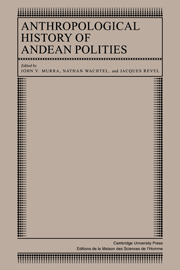Book contents
Part IV - Symbolic representations and practices
Published online by Cambridge University Press: 05 October 2010
Summary
Recent years have witnessed a flowering of studies devoted to “Andean symbolism,” the subject of a noted symposium, part of the 1976 Congress of Americanists (B. Isbell 1978). Many of these papers used a structural analysis, which has proved productive for the Andean world. Billie-Jean Isbell's assertion at the time, that the Andean peoples were spontaneous structuralists of astounding subtlety and sophistication, may well be accurate. To elucidate this involves methodological questions. It is not enough, after all, to describe the conscious functioning of Andean thought: An effective understanding of an ethnographic classification also depends on thorough awareness of the social morphology and the economic system. The very same principles guide not only practice but also the mental representations. The latter are not just “superstructures,” more or less autonomous; they are active components in the reproduction of the total social universe.
Following on his work localizing the ceque lines and ayllu of the circum-Cusco area (1964 and later), R. T. Zuidema (Chap. 11, this volume) shows how the hydrographical network, tamed by the irrigation system, is also “humanized” by being fitted into upper and lower moieties. The same patterning governs the perception of the ecology, the location of social units, rituals, and myth.
- Type
- Chapter
- Information
- Anthropological History of Andean Polities , pp. 175 - 176Publisher: Cambridge University PressPrint publication year: 1986



